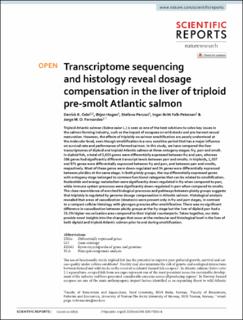| dc.contributor.author | Odei, Derrick Kwame | |
| dc.contributor.author | Hagen, Ørjan | |
| dc.contributor.author | Peruzzi, Stefano | |
| dc.contributor.author | Falk-Petersen, Inger-Britt | |
| dc.contributor.author | Fernandes, Jorge Manuel de Oliveira | |
| dc.date.accessioned | 2021-02-18T13:19:46Z | |
| dc.date.available | 2021-02-18T13:19:46Z | |
| dc.date.created | 2020-10-08T12:09:54Z | |
| dc.date.issued | 2020 | |
| dc.identifier.citation | Odei, D. K., Hagen, Ø., Peruzzi, S., Falk-Petersen, I.-B. & Fernandes, J. M. O. (2020). Transcriptome sequencing and histology reveal dosage compensation in the liver of triploid pre-smolt Atlantic salmon. Scientific Reports, 10: 16836. doi: | en_US |
| dc.identifier.issn | 2045-2322 | |
| dc.identifier.uri | https://hdl.handle.net/11250/2728962 | |
| dc.description.abstract | Triploid Atlantic salmon (Salmo salar L.) is seen as one of the best solutions to solve key issues in the salmon farming industry, such as the impact of escapees on wild stocks and pre-harvest sexual maturation. However, the effects of triploidy on salmon smoltification are poorly understood at the molecular level, even though smoltification is a very sensitive period that has a major influence on survival rate and performance of farmed salmon. In this study, we have compared the liver transcriptomes of diploid and triploid Atlantic salmon at three ontogeny stages: fry, parr and smolt. In diploid fish, a total of 2,655 genes were differentially expressed between fry and parr, whereas 506 genes had significantly different transcript levels between parr and smolts. In triploids, 1,507 and 974 genes were differentially expressed between fry and parr, and between parr and smolts, respectively. Most of these genes were down-regulated and 34 genes were differentially expressed between ploidies at the same stage. In both ploidy groups, the top differentially expressed genes with ontogeny stage belonged to common functional categories that can be related to smoltification. Nucleotide and energy metabolism were significantly down-regulated in fry when compared to parr, while immune system processes were significantly down-regulated in parr when compared to smolts. The close resemblance of enriched biological processes and pathways between ploidy groups suggests that triploidy is regulated by genome dosage compensation in Atlantic salmon. Histological analysis revealed that areas of vacuolization (steatosis) were present only in fry and parr stages, in contrast to a compact cellular histology with glycogen granules after smoltification. There was no significant difference in vacuolization between ploidy groups at the fry stage but the liver of diploid parr had a 33.5% higher vacuolization area compared to their triploid counterparts. Taken together, our data provide novel insights into the changes that occur at the molecular and histological level in the liver of both diploid and triploid Atlantic salmon prior to and during smoltification. | en_US |
| dc.language.iso | eng | en_US |
| dc.publisher | Nature | en_US |
| dc.relation.uri | https://www.nature.com/articles/s41598-020-73814-6#Sec17 | |
| dc.rights | Navngivelse 4.0 Internasjonal | * |
| dc.rights.uri | http://creativecommons.org/licenses/by/4.0/deed.no | * |
| dc.title | Transcriptome sequencing and histology reveal dosage compensation in the liver of triploid pre-smolt Atlantic salmon | en_US |
| dc.type | Peer reviewed | en_US |
| dc.type | Journal article | en_US |
| dc.description.version | publishedVersion | en_US |
| dc.rights.holder | © 2020 The Author(s) | en_US |
| dc.subject.nsi | VDP::Landbruks- og Fiskerifag: 900::Fiskerifag: 920 | en_US |
| dc.subject.nsi | VDP::Matematikk og Naturvitenskap: 400::Basale biofag: 470 | en_US |
| dc.source.volume | 10 | en_US |
| dc.source.journal | Scientific Reports | en_US |
| dc.identifier.doi | 10.1038/s41598-020-73814-6 | |
| dc.identifier.cristin | 1838181 | |
| dc.relation.project | Norges forskningsråd: 248028 | en_US |
| dc.source.articlenumber | 16836 | en_US |

